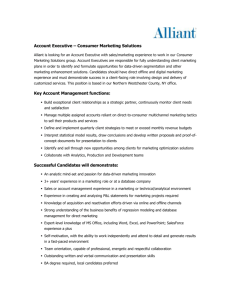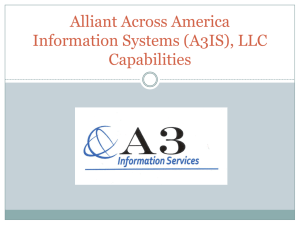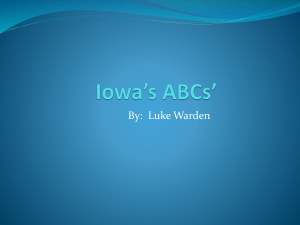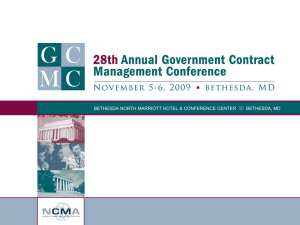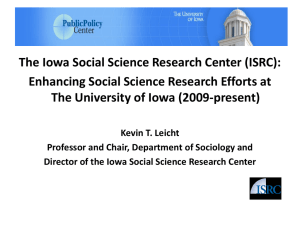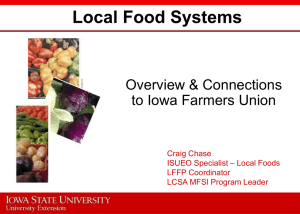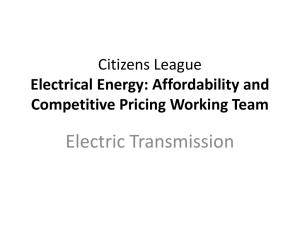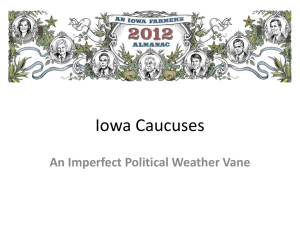Development Process (LTF)
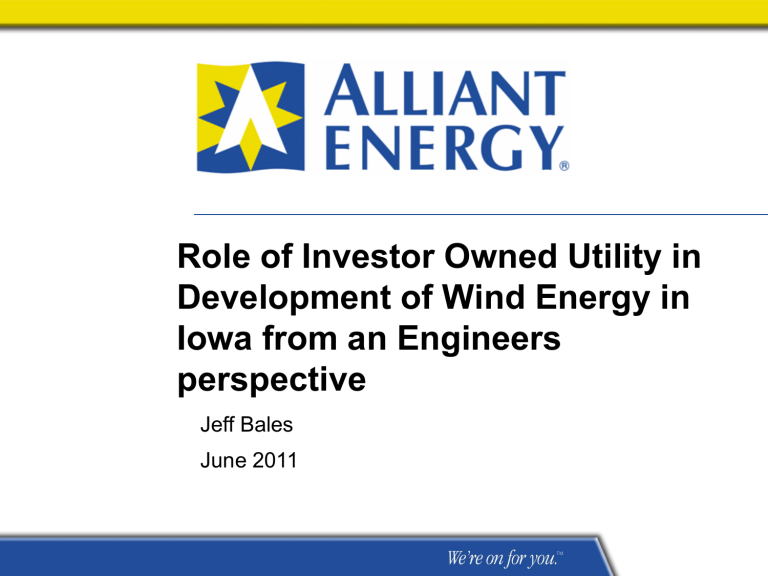
Role of Investor Owned Utility in
Development of Wind Energy in
Iowa from an Engineers perspective
Jeff Bales
June 2011
2
Who are we?
Alliant Energy Corporation is a public utility holding company headquartered in
Madison, Wisconsin. Alliant Energy's two regulated utilities include Interstate
Power and Light Company (IPL) and Wisconsin Power and Light Company
(WPL). In addition it has several other non regulated entities. Two of those are
RMT and CRANDIC.
WPL generates, purchases and sells power in Wisconsin and has some ownership in the American Transmission Company who provides transmission service in Wisconsin
IPL generates, purchases and sells power in Iowa and Minnesota. Its service territory serves the southern part of Minnesota and also is scattered throughout the state of Iowa. IPL sold their transmission system to ITC (Iowa
Transmission Company)
3
Who are we ? Alliant Service Territory
The IPL service territory is scattered due to the merging of several smaller utilities in the past 20 years named Iowa Electric, Iowa Southern, and
Interstate Power and Light.
Energy Delivery Update
Technology
Confidential
5
Alliant Strategic Plan
Alliant Energy Utilities Strategic Plan is built on three key elements:
Competitive Costs
Reliable Service
Balanced Generation
6
Balanced Generation
Our sources of electric power in 2007 were 54% coal, 6 % natural gas and
39% Purchased Power.
The 39% purchased power leaves our customers to unpredictable fuel costs.
These fuel cost can sometimes make up 50% of our customers bills.
Due to state and federal legislation it is important that we have a balance mix of generation.
Alliant now owns and operates a total of three wind farms
Cedar Ridge (68 MW near Fon Du Lac Wisconsin)
Whispering Willow (200MW near Iowa Falls Iowa)
Bent Tree (200MW near Albert Lea Minnesota)
Thru second quarter of this year the owned wind farms and Purchase Power
Agreements made up 6% of the generation in our service territory.
We have several locations under development such that if it makes sense to add more wind to our fleet we will do so.
7
Role of Investor Owned Utility in
Development of Wind
Investor owned utilities are able to see the entire process from beginning to end.
Have key roles in the paradigm shift as significant milestones occur.
Contracts for Purchase Power Agreements
Owning Wind Farms
Operating Wind Farms
8
Role of Investor Owned Utility in
Development of Wind
Owning Wind Farms
Forecasting the output of wind farms
Impact is to Production Tax Credits that are forecasted in our financials on a quarterly basis.
Impact to our fuels forecast
Impact to the remaining fleet of generation in the area
9
Development Process – Long Term
Forecast (LTF)
10
11
Development Process (LTF)- Wind Source
The P50 number represents the probability of that level of generation being met.
Probability numbers are used for different circumstances relative to bank loans and in some instances negotiations around a purchase power agreement.
This number only takes into account the assumed losses and the statistics around long term data.
One forecasting vendor is presently challenging some of the historical information coming out of these reports (nationally) based on poor data sets from the different ways of collecting long term data and comparisons to actual data.
Part of due diligence is the comparison of a utility wind owned facility to a purchase power agreement.
Bottom Line- When comparing different alternatives understand which P value you are comparing to.
12
Development Process (LTF)-
Transmission
Midwest Independent System Operations is the controlling entity for the state of Iowa at the Regional level
Two transmission utilities presently provide the majority of services for MISO
Our two owned wind farms are located in the Iowa Transmission Company footprint of service.
Currently each of our 200MW wind farms are working within a provisional
Generator Interconnect Agreement.
MISO continues to do studies to accommodate customer base however timing of such studies and implementation seem to be in the 5-7 year time frame and not in the current two to three year cycle.
Optional Studies have been completed by MISO for Alliant under, at that time, current conditions and also with certain assumptions by the customer.
Under these conditions a Provisional Generator Interconnect Agreement can be pursued with implementation in the 14 month timeframe while larger studies continue.
13
Example of Optional Study Result (LTF)
14
Development (LTF)- Bringing them together
Previous number represents the Provisional Limit and is posted by MISO quarterly. In some instances this can change which will effect your forecasted outputs.
How do Purchase Power Agreements handle Provisional status ?
Internally owned Wind farms
15
16
Power Curves
EAPC vs. Calculated
250.00
200.00
150.00
100.00
50.00
0.00
0 5 10 15
Wind Speed m/s
20 25
EACP Power Curve
Calculated Power Curve
17
Development Process (LTF)-Internal xxxx - May 2011
Variance Report
70,000
60,000
50,000
40,000
30,000
20,000
10,000
0
-10,000
-20,000
Forecast
Actual
Variance
Wind
47,925
60,920
12,995
Curtailments
0
-12,112
-12,112
Reduction due to 165 MW Op
Limit
0
-1,163
-1,163
Total
47,925
47,645
-280
18 xxxx Observed Power Curve
MAY 2011
180
160
140
120
100
80
60
40
20
0
0
-20
2 4 6 8 10
Wind Speed m/s
12 14 16 18
Series1
19
Development Process (LTF)
What makes up the other curtailments?
Two buckets
Operations Curtailment
Economic Curtailment
20
Development Process(LTF)-Operations
Curtailment (MISO document June 2010)
Wind Farm that is registered Intermittent Resource or (IR) cannot be dispatched as part of the real-time dispatch software at MISO
Result of this necessitates manual curtailment by MISO to relieve transmission constraints
LMP node under this condition does not reflect congestion
Results of these conditions were that until April of this year 90% of curtailments were operational in nature and not economically based.
21
22
Development Process(LTF)- Economic
Curtailments
Beginning in April Alliant Energy wind farms began seeing much more volatility in LMP prices at the wind farms.
Result of this necessitated manual curtailment by Alliant GDC to relieve economic concerns over negative LMP prices
Due to timing issues Alliant GDC could not keep up with the changing 5 minute
LMP pricing.
Results of these conditions were that a large shift in curtailments between operations and economic began to change on a percentage basis.
As a result Alliant has signed up Wind Farms for Dispatchable Intermittent
Resource so it can take advantage of automatic control to maximize efficiency.
Two of our Three wind farms will implement this feature in September.
23
Forecasting- Economic Curtailments
Date
1-Apr-11
2-Apr-11
3-Apr-11
4-Apr-11
5-Apr-11
April-11
Generation
(Revenue) /Expense
($28,514.55)
$85,561.15
($10,861.37)
$13,299.28
($10,103.95)
Volume
-1,963,000
-1,040,000
-977,000
-1,499,000
-609,000
24
Development Process (LTF)-Economic
Existing Purchase Power Agreements do not have language to address issues around negative LMP.
When new PPA are negotiated this will definitely be taken into account.
Will have impact on developers ability to execute on loans and quality of their forecast
Present PPA did not have scrutiny around producing at negative rates.
Impacts operations as well with most contract services being driven off availability.
Present take is on shoulder months where load vs generation has base units backed off to minimum will be the months where forecasts will be impacted.
No longer can assume the best wind months are the best for wind farm output presently at Alliant.
25
Summary Long Term Forecasting
Investor owned utilities are learning that the wind forecast is just one component of the forecast.
As wind generation continues to make penetration expect local congestion issues to continue. Investor own utilities will need to understand all conditions as the wind becomes more of a segment of the generation on how there fleet of generation will be dispatched.
Wind farms must develop a y=f(x) concept to ensure they manage each component of the forecast well to understand the dynamics moving forward and are able to report to their customer base.
Vendors and suppliers of forecasting services will need to get into the operation segment of wind farms to understand controls and maintenance to provide turn key services. Signals from turbines as it relates to local conditions will become next generation of improvement in short term forecasting
